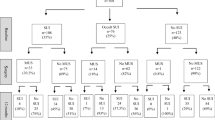Abstract
Introduction and hypothesis
The purpose of this study was to evaluate the predictors of de novo stress urinary incontinence (SUI) in patients undergoing a tension-free vaginal mesh procedure (TVM) for pelvic organ prolapse (POP).
Methods
Sixty-five patients without SUI were assessed with regard to voiding function by a pressure flow study and clinical characteristics.
Results
The mean age of the patients was 67 ± 8.3. Of the 65 patients, 41 (63 %) maintained urinary continence postoperatively and 24 (37 %) showed de novo SUI. In univariate analysis, the de novo SUI group included a significantly higher proportion of patients with preoperative obstruction, defined as moderate or greater obstruction according to the Blaivas nomogram (29 vs 7 %, P = 0.035). In multivariate analysis, urethral obstruction was an independent predictor of de novo SUI with an odds ratio of 12.616 (95 % confidence interval 1.580–268.731).
Conclusions
Preoperative evaluation of urethral obstruction will contribute to prediction of de novo SUI combined with a conventional diagnosis of occult SUI.

Similar content being viewed by others

References
Altman D, Väyrynen T, Engh ME et al (2011) Anterior colporrhaphy versus transvaginal mesh for pelvic-organ prolapse. N Engl J Med 364(19):1826–1836
Caquant F, Collinet P, Debodinance P et al (2008) Safety of Trans Vaginal Mesh procedure: retrospective study of 684 patients. J Obstet Gynaecol Res 34(4):449–456
Vaiyapuri GR, Han HC, Lee LC et al (2011) Use of the Gynecare Prolift® system in surgery for pelvic organ prolapse: 1-year outcome. Int Urogynecol J 22(7):869–877
Latini JM, Kreder KJ Jr (2005) Associated pelvic organ prolapse in women with stress urinary incontinence: when to operate? Curr Opin Urol 15(6):380–385
Bai SW, Jeon MJ, Kim J et al (2002) Relationship between stress urinary incontinence and pelvic organ prolapse. Int Urogynecol J Pelvic Floor Dysfunct 13:256–260
Stanton SL, Hilton P, Norton C et al (1982) Clinical and urodynamic effects of anterior colporrhaphy and vaginal hysterectomy for prolapse with and without incontinence. Br J Obstet Gynaecol 89:459–463
Borstad E, Rud T (1989) The risk of developing urinary stress-incontinence after vaginal repair in continent women: a clinical and urodynamic follow-up study. Acta Obstet Gynecol Scand 68:545–549
Colombo M, Maggioni A, Zanetta G et al (1996) Prevention of postoperative urinary stress incontinence after surgery for genitourinary prolapse. Obstet Gynecol 87:266–271
Kleeman S, Vassallo B, Segal J et al (2006) The ability of history and a negative cough stress test to detect occult stress incontinence in patients undergoing surgical repair of advanced pelvic organ prolapse. Int Urogynecol J Pelvic Floor Dysfunct 17(1):27–29
Al-Mandeel H, Ross S, Robert M et al (2011) Incidence of stress urinary incontinence following vaginal repair of pelvic organ prolapse in objectively continent women. Neurourol Urodyn 30(3):390–394
Richardson D, Bent A, Ostergard D (1983) The effect of uterovaginal prolapse on urethrovesical pressure dynamics. Am J Obstet Gynecol 146:901–905
Bump R, Fantl J, Hurt W (1988) The mechanism of urinary continence in women with severe uterovaginal prolapse: results of barrier studies. Obstet Gynecol 72:291–295
Kuribayashi M, Kitagawa Y, Narimoto K et al (2011) Postoperative voiding function in patients undergoing tension-free vaginal mesh procedure for pelvic organ prolapse. Int Urogynecol J 22(10):1299–1303
Blaivas JG, Groutz A (2000) Bladder outlet obstruction nomogram for women with lower urinary tract symptomatology. Neurourol Urodyn 19(5):553–564
Debodinance P, Berrocal J, Clavé H et al (2004) Changing attitudes on the surgical treatment of urogenital prolapse: birth of the tension-free vaginal mesh. J Gynecol Obstet Biol Reprod (Paris) 33(7):577–588
Takeyama M, Uesaka Y, Itoh S et al (2007) Feasibility of the tension-free vaginal mesh procedure using soft polypropylene mesh (Gynemesh PS) Japan. Int Urogynecol J Pelvic Floor Dysfunct 18(Suppl 1):S46–S47
Kato K, Suzuki S, Yamamoto S et al (2009) Clinical pathway for tension-free vaginal mesh procedure: evaluation in 300 patients with pelvic organ prolapse. Int J Urol 16(3):314–317
Haylen BT, de Ridder D, Freeman RM et al (2010) An International Urogynecological Association (IUGA)/International Continence Society (ICS) joint report on the terminology for female pelvic floor dysfunction. Int Urogynecol J 21(1):5–26
Haessler AL, Lin LL, Ho MH et al (2005) Reevaluating occult incontinence. Curr Opin Obstet Gynecol 17:535–540
Araki I, Haneda Y, Mikami Y et al (2009) Incontinence and detrusor dysfunction associated with pelvic organ prolapse: clinical value of preoperative urodynamic evaluation. Int Urogynecol J Pelvic Floor Dysfunct 20(11):1301–1306
Karateke A, Tug N, Cam C et al (2011) Concomitant surgical correction of occult stress urinary incontinence by TOT in patients with pelvic organ prolapse. Eur J Obstet Gynecol Reprod Biol 154(1):105–107
Liapis A, Bakas P, Georgantopoulou C et al (2011) The use of the pessary test in preoperative assessment of women with severe genital prolapse. Eur J Obstet Gynecol Reprod Biol 155(1):110–113
McGuire EJ, Lytton B, Pepe V et al (1976) Stress urinary incontinence. Obstet Gynecol 47:255–264
Blaivas JG, Olsson CA (1988) Stress incontinence: classification and surgical approach. J Urol 139(4):727–731
Fatton B (2009) Is there any evidence to advocate SUI prevention in continent women undergoing prolapse repair? An overview. Int Urogynecol J Pelvic Floor Dysfunct 20(2):235–245
Brubaker L, Cundiff GW, Fine P et al (2006) Abdominal sacrocolpopexy with Burch colposuspension to reduce urinary stress incontinence. N Engl J Med 354(15):1557–1566
Conflicts of interest
None.
Author information
Authors and Affiliations
Corresponding author
Rights and permissions
About this article
Cite this article
Kuribayashi, M., Kitagawa, Y., Narimoto, K. et al. Predictor of de novo stress urinary incontinence following TVM procedure: a further analysis of preoperative voiding function. Int Urogynecol J 24, 407–411 (2013). https://doi.org/10.1007/s00192-012-1882-0
Received:
Accepted:
Published:
Issue Date:
DOI: https://doi.org/10.1007/s00192-012-1882-0



